M20 engine swap into E21 320i
Goal: swap in an M20B25 engine into a US E21 320i body
Performed on: '83 320i with an engine from an '89 325i
Applies to: '80+ E21s, maybe all E21s... swapping in other M20s (M20B27, etc) should be similar
Time needed: who knows... took me about 3 months working every weekend
Disclaimer: I do not assume any responsibility for the correctness of these instructions or their applicability to the specified models. Use at your own risk! Also, use commons sense, don't do stupid things.
Overview:
As we all know, the stock US 320i engine is weak by today's standards, so I got the idea that it would be really fun to put a more powerful engine in that light E21 chassis. Why M20B25? Like all M20s, it's easy to fit physically since there was an E21 that came from the factory with an M20, and the M20B25 is the most powerful of the M20 family and has the highest potential for upgrades. It has relatively modern electronic engine management which is very self-contained and thus easy to swap in (unlike newer BMW engines, whose management is integrated with other chassis systems, which makes them more difficult to swap into an old car). M50/M52/M54 motors may also be reasonable choices, but will involve additional difficulties, specifically related to the transmission and driveshaft... and possibly electronics too. But they do have a more modern design (24V, variable valve timing, etc), so they should be considered too (and some of the info here will apply to them as well).
Ok, enough small talk, now here's how to do it. The procedure is OVERLY detailed in some cases... it may seem like I'm stating the obvious, but I think it's a good idea to do that anyway, just so there's no confusion, and so that people know what to expect before even starting the swap.
UPDATE (May 2015): I've put up all the pictures I took during the whole process here.
Parts
- M20B25 engine
- Everything that's attached to the M20 engine, including:
- Wiring harness and Motronic ECU, along w/ the 3 engine relays (main, fuel pump, O2 sensor) that are attached to the wiring harness (you don't need the E30 fuse box, but it would help to have the wire/connector that goes from the fuse box to the round engine harness plug)
- Intake manifold, MAF, sensors, ICV, all vacuum hoses
- Exhaust manifold (an aftermarket or stock header for any M20 will work too)
- All fuel injection and ignition parts, starter
- Alternator
- (I personally got rid of the A/C and power steering pump. Each is on a separate belt, so removing them doesn't interfere with the alternator or water pump.)
- Front subframe/crossmember from a 6-cyl E21 (nothing else fits without major modification)
- Engine mount brackets (metal) and rubber mounts from a 6-cyl E21 (the rubber mounts from a E30 6-cyl may fit, possibly with some modification)
- Clutch assembly that came with the M20B25 (flywheel, clutch disc, pressure plate, etc). It's also possible to use the lighter-weight flywheel from a 6-cyl E21 but I don't know if it's a direct bolt-on.
- Transmission from a 6-cyl E21 (or from an E30/E28, but see this link)
- Shifter assembly and transmission crossmember from whatever transmission you're using (shifter assembly includes the shift lever, shifter support plate, selector rod, and selector-rod-to-selector-shaft coupling).
- Clutch slave cylinder that came with whatever transmission you're using (the original one from the 320i looks the same, so it might work too, but I don't know for sure).
- Driveshaft: get the stock 320i driveshaft professionally shortened to fit (or, if using an E21 6-cyl transmission, you can get the stock driveshaft from the same car. Note that 4-speed and 5-speed trannies and driveshafts have different lengths and flanges, so just get everything from the same model.) The flex disc/guibo is the same part number for all 5-speed E21s and E30s.
- Exhaust downpipe from an E30 325i with a relocated O2 sensor bung (the stock position makes the O2 sensor hit the frame rail) or an aftermarket header made for any M20 engine (again, with an O2 sensor bung).
- Custom-made exhaust piping and rear muffler to fit whatever downpipe/header you're using; a complete Euro E21 320/6 exhaust may fit with some modification. (Note that the 323i dual exhaust does NOT fit without very major modification to sheet metal)
- Radiator, radiator mounts, radiator hoses & expansion tank from a 6-cyl E21. Bottom radiator mounts (rubber circular mounts) from any 6-cyl E30 or E21. The expansion tank could also be from an early-style E30 (325e/i). Other setups are also possible, but I think this is the easiest one.
- Water pump and thermostat-to-heater-core hose from a 2.7L (ETA) M20 engine (from an E30 325e).
- Belt-driven fan from the M20B25 engine if you have a 1980+ E21. It fits fine with the 323i radiator in front of it. However, I've read that on '79 and older cars, you'll probably have to use an aftermarket electric fan.
- Air intake routing/filter is easily replaced with a cold-air intake (cone filter, etc.). A stock E30 air box should also work with some custom brackets.
- Throttle cable from an E30 325i (modified somehow to hook onto the E21 pedal), or the stock E21 throttle cable modified somehow to hook onto the E30 engine (I did the latter with modifications to the E30 throttle body levers).
- Oil cooler from E30 325i (it's also possible to bypass the oil cooler by using the oil filter housing from an ETA (325e) engine, but it's always better to have more cooling).
- Fuel system: use the external fuel pump from an early-style E30 (up to '87). Remove the E21 fuel accumulator because it interferes with the function of the E30 fuel pressure regulator that's mounted on the engine. Custom hose hookups are required for this (I used 1/2" and 5/16" sizes). I also used an E30 fuel filter because it's easier to hook up with regular hoses - the E21 filter requires banjo fittings.
- New high-pressure fuel hoses for the engine compartment (I used 5/16" inner-diameter fuel injection hoses, a total of about 6 feet / 2 meters)
- Fuel charcoal canister - either the original one, or one from an E30 - both work the same way and both will require custom mounting.
- Tachometer from a 6-cyl E21 (or possibly from another 6-cyl BMW from that era - E12/E23/E24/E28/E30, although those may require modification or custom mounting to fit). The stock 320i tachometer works, but shows 1.5 times the actual RPM.
- Cables, brackets, etc. to relocate the battery to the trunk (a battery cable from an E30 works) - for more space in the engine compartment, plus better front-to-back weight distribution
- New 8-gauge wire to power the fuse box (about 6ft long)
Procedure
Read this first
Read this entire procedure in detail before even starting to work on your car. This is important.
Preparing the E21 320i
- As you remove stuff from the E21, don't throw anything away unless you're absolutely certain that you won't be reusing it (again, read the whole procedure in advance). It's also a good idea to label things and mark where they came from. Also, take lots of pictures... they're free with a digital camera and will help you remember how things were hooked up originally.
- Drain coolant & oil, remove fan, radiator & hoses, belts, disconnect heater hoses at the firewall, etc.
- It makes things easier for later if you also remove the front grilles and possibly the bumper.
- Remove the air intake box and piping
- Unplug the engine wiring harness from the fuse box (note: you'll need the part of the E21 engine wiring harness that plugs into the fuse box, so don't throw that away), disconnect and remove the ignition coil and all other places where the engine harness attaches to the chassis. Disconnect battery cable from starter (or if you don't have enough clearance, you can do that later, after you cut out the battery tray).
- Under the battery tray, there's a fuel vapor canister. Mark the hoses that connect to it and disconnect them (note: one of them in inlet, the other is outlet, so make sure you mark which one is which).
- Cut off the battery tray with... something that can cut metal. Save the fuel vapor canister that's under it - it will need to be reused, but obviously relocated.
- Take off the exhaust (you can leave the exhaust manifold on the engine if you want). You'll need a different (bigger) exhaust anyway, so feel free to remove the entire exhaust - including the rear section - right now.
- Detach the driveshaft from the transmission. You need to unbolt the center bearing from the body of the car for that purpose. You can also completely remove the front section of the driveshaft at this time if you want. You need a box-end wrench (I think 19mm but I'm not sure). The rear seaction can remain on the car.
- Remove the shifter linkage. You do that by pulling the little clips on the selector rod and removing that selector rod. The shifter plate is held by 2 bolts onto the transmission and 1 nut onto the body of the car. You don't need to remove the lever from the shifter plate.
- Remove M10 engine & tranny (I pulled them up through the engine bay as one unit, no problems there). I'm not going to go into detail - it's pretty self-explanatory, just disconnect everything that's connected to the engine and lift it with a hoist. It helps to have a load leveler on the engine hoist.
- If you're going to be using the E30 tranny, you need to pound up the transmission tunnel with a hammer just where the rearmost end of the tranny would touch it (otherwise it touches and the tranny barely fits... and transfers vibrations to the body of the car). It doesn't need too much pounding.
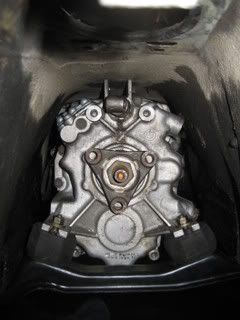
Taking stuff from the E30 325i
- Take photos of the engine bay from various angles so you can refer to them later if necessary.
- Drain radiator & oil
- Remove air intake up to (and including) the air flow meter (AFM). The AFM connector will stay with the engine, strap it somewhere on the engine.
- Remove the fan, radiator, radiator hoses
- Disconnect heater hoses at firewall (coolant will leak profusely, be prepared)
- Remove A/C compressor & power steering pump if you're not planning to use them on the E21. It's easiest to do that now, so that you have more room when taking the engine out.
- Remove glove box (screws are behind it, accessible when it's closed) in order to expose the ECU.
- Disconnect ECU connector (and the little one next to it) and remove ECU. We won't be using the little connector for the E21, so don't worry about it.
- The cable that goes to the ECU goes through the firewall. It has a large rubber gromet around it. Push that gromet outward from inside the car (one side at a time) and it will come out. Once the gromet is out, the hole in the firewall is big enough for the entire connector to go through (seriously). So now you have your entire engine wiring harness in the engine bay. Don't disconnect it from the engine itself.
- Disconnect engine wiring harness from the positive battery terminal attached to the firewall and the ground cable at the strut tower (mark each cable you disconnect so you know which is which... and/or take a picture).
- Disconnect engine wiring harness from the ignition coil, marking each wire so that you remember what they're for and which one is + and which is -.
- Again, take photos as you disconnect things.
- At this point the only parts of the engine wiring harness that are still attached to the body of the car should be the round connector and the power cable one going to the fuse box. Unplug the round connector.
- That power cable from the fuse box to the engine harness is actually not part of the harness. It's a separate cable that goes directly to the positive battery terminal. Remove the zip ties around the central part of the engine wiring harness and pull out that one cable. Retie everything else back.
- Disconnect driveshaft from tranny
- Disconnect/remove shifter linkage
- Disconnect clutch hydraulic line from the juncture next to the firewall.
- If you want to take out the engine + tranny as one unit, you can (that's what I did). You'll need a load leveler as it's a very tight fit. There's a very annoying rod at the top of the tranny tunnel that the tranny gets caught on... but it is indeed possible to take the engine and tranny out as one unit throught the engine bay.
- Alternatively, you can disconnect the transmission from the engine and pull the engine by itself. See other tutorials on how to remove the tranny.
- Pull engine (or engine+tranny) out. This is how mine came out:
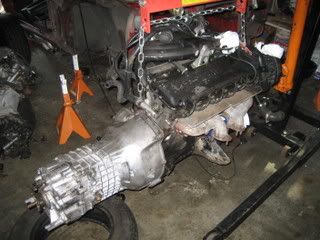
- Depending on how much time you're planning to leave the engine out, you may choose to put it on an engine stand. I don't recommend using a tire as a stand because it may crush the oil pan gasket and cause an oil leak later. I personally just left it hanging from the hoist for a couple of days until I was ready to put it into the E21.
- As the engine is hanging, remove the engine mount brackets from it (four 13mm bolts each), and replace them with the E21 6-cyl engine brackets (pay attention to left/right, they're different).
- Remove the flywheel cover from the rear underside of the engine (where it mates to the transmission) because if you don't, it will hit the E21 steering rack. Either now or later, fabricate a smaller aluminum or steel plate to protect the flywheel, but still leave room for the steering rack. It might be better to do that later, when the engine is already in the E21 since then you'll know exactly how much room you need for the steering rack.
Putting the M20 engine into the E21
- Unbolt steering rack from subframe. This is a good time to replace steering rack bushings.
- The next few steps assume you want to put in the M20 engine and transmission as one unit. If you want to put them in separately, you can skip the removal of the steering rack, just swap subframes and drop the engine in through the engine compartment. If putting in engine+tranny together, read on.
- Remove the steering rack completely. You need to disconnect the steering rack from the steering shaft (the steering "knuckle" slides out when you untighten the 10mm bolt) and also detach the tie rods. Good time to replace the tie rods.
- Remove subframe (a.k.a. front crossmember). It's not necessary to remove the suspension, just undo the bolts that connect the control arms to the subframe and then the ones connecting the subframe to the body and it will fall off. At this point the engine bay should be fully open so that you can slide the engine+tranny in from under the car. It is not necessary to remove the sway bar.
- Lie the M20 engine on its side onto a furniture dolly (low, flat surface with wheels). The idea is to get the engine as low as possible to the ground, so we can slide it under the car. Something like this:
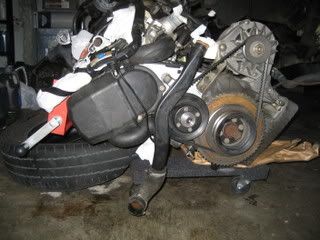
- Lift the front of the car as high as you can get it and slide the engine underneath. I used large 24" jack stands and they weren't enough. I had to remove the throttle cable plate and a few other protruding brackets from the engine (see how it's not fitting in the first picture below), and also lift the car by another inch or two on one side to be able to slide the engine underneath (the E30 Bentley manual came in handy there... lol).
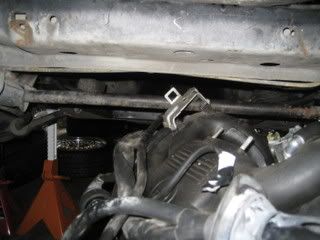
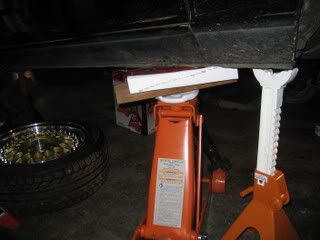
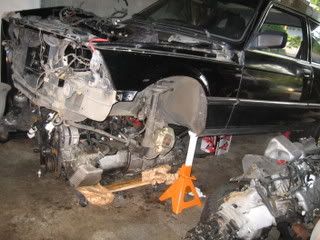
- Lower the car a bit, making sure it doesn't hit the engine as it's getting lowered.
- Reattach the engine hoist fromt he top, through the engine compartment
- Lift up the engine + tranny. Level them roughly horizontally - the way they normally sit in the car. If necessary, support the transmission with a jack or jack stand (it wasn't necessary for me because I had a load leveler).
- Working under the side of the car, put in the new subframe (the one from a 6-cyl E21). I used the rubber motor mounts from a 6-cyl E21, but it may also be possible to use the ones from the E30. Don't lie or put your limbs directly under the engine, since it's being supported by the engine host at this point. Having 2 people for this step would be very helpful. If necessary, lift the engine more, such that its engine mounts are not even touching the subframe. When tightening the subframe-to-chassis bolts, don't overtorque... check the correct torque in a manual. I broke a bolt when tightening the new subframe to the body with less than 60lb-ft of torque. Bolt the control arms to the new subframe. To make the control arm holes line up, have an assistang press the bottom of the wheel hub inward (in my case, I even had rims/tires still there, which makes it easier).
- Slowly lower the engine onto the subframe, making sure the engine mount holes fit the studs. It may take some wiggling to achieve that, and it is important that the engine+tranny assembly be level at this point (otherwise the back of the engine will be hitting the firewall, making it impossible for the engine mounts to fit into place). Don't fully release the load off of the engine hoist yet.
- Support the back of the transmission with a jack stand (you don't want the tranny's weight pulling on the engine mounts).
- Now you can fully release the engine hoist, wiggle the engine a bit to make sure everything is in its place and safely attached, and finally, remove the hoist/chains from the engine.
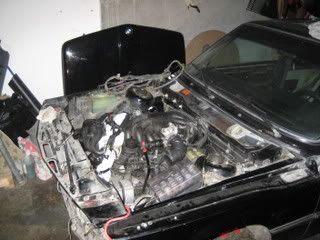
- Put the nuts on the top and bottom of the engine mounts (deep socket required for the top ones).
- If using an E30 transmission, drill new holes into the E30 transmission crossmember such that they fit the studs on the E21 body. Bolt in the E30 transmission crossmember using E30 or E21 transmission mounts (E21 ones are stiffer, so if you find 2 of them, use them). You'll need to slide the mounting studs to their rearmost position. It almost doesn't fit, but does...
- If using an E21 transmission (from a 6-cyl car), you can use the stock 320i transmission crossmember or the one that came with the 6-cyl tranny. Use an E21 transmission mount (just 1), or an upgraded one. I used a polyurethane one made for an E36 - they're all the same size.
- Obviously, now you can remove the jack or jack stand that you were using to support the tranny.
- If the top of the transmission is hitting the body of the car, and you didn't previously pound the transmission tunnel up with a hammer, you can now just lift the tranny up with a floor jack such that it pushes hard against the tunnel and eventually bends it (I know, this is ghetto, but it works).
Cooling system
- There are many ways to do this, but I'll describe how I did it. I used all OEM parts.
- Get a water pump from an ETA engine (E30 325e or E28 528e) because it has an additional hose neck on the passenger side, where we're going to mount the coolant expansion tank (as opposed to the E30 325i setup, where the expansion tank is on the driver's side and connects via a T-connection to the hose that runs from the heater outlet to the thermostat housing)
- Install the ETA water pump, remount the pulley, tension the belt, etc. To replace a water pump on this M20 engine, you need to remove the distributor cap & rotor, as well as the upper timing belt cover.
- Get an ETA coolant hose that goes from the thermostat housing to the heater core outlet (the stock one from an E30 325i has a T-split with another hose going to the coolant expansion tank... we want to eliminate that, because we'll be mounting the expansion tank on the other side of the engine). Here you can see the difference between the two:
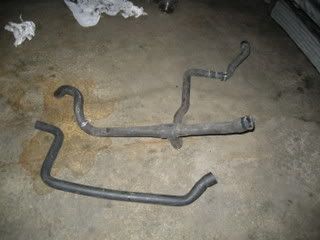
- Get an E21 323i radiator. It makes life much easier because it fits nicely in the space where the A/C condenser was (which is the stock place for it on a 323i), and the hoses line up perfectly
- To install the 323i radiator, you'll have to cut off the tack-welded cover piece that the US E21s have. In the end it should look something like this:
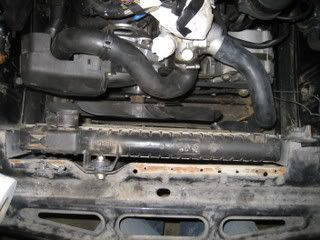
- Get radiator hoses from a E21 323i. They are specific to that model and not readily available in the US... may have to budget some time for these to be delivered from Germany. Alternatively, you could use custom hoses or something else that could roughly fit.
- Cut off and remove the stock radiator metal brackets (I used a Dremel):
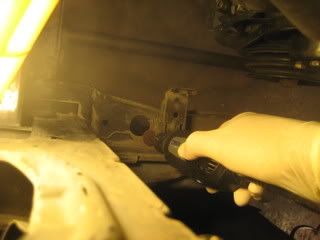
- The US 320i body already has all the holes necessary to mount a 323i radiator, so you don't need to drill anything. However, one of the stock US radiator brackets covers one of the holes, so make sure you remove all remnants of that bracket in that spot in order to fully uncover the hole (see picture).
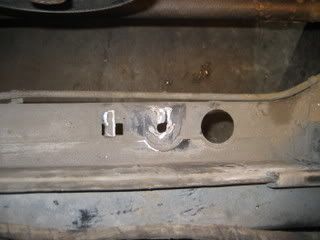
- Use OEM 323i bottom radiator mounts (they are rubber mounts) or, if you don't have them, do what I did: take the stock 320i top radiator mounts and cut them off as shown in the picture. Then put the rubber circular thingies from the top mounts of the E30 radiator on top of the cut E21 mounts. You'll end up with something very close to the stock 323i mounts, and they fit perfectly into the circular holes on the bottom of the 323i radiator.
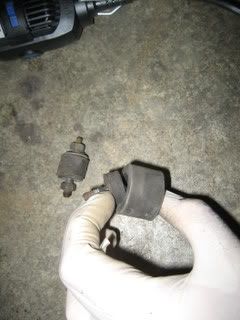
- For the top mount, again, the US body has the correct hole, but you need the 323i rubber mount (plentifully available in the US). I put a bolt and some washers through it and it worked great. It was a 13mm-head bolt of some sort.
- Make custom mounts for the coolant expansion tank and mount it on the passenger-side strut tower.
- I used an OEM 323i hose to connect the expansion tank to the ETA water pump.
- There's also a little breather hose that connects the top of the radiator to the expansion tank. I used the equivalent one from an E30 there, but I'm sure one from a 323i would work too.
- Put in the original engine-driven fan (stock one from the E30 325i). It fits without any trouble. NOTE: I've heard that pre-1980 E21 bodies have less room in the front, so in those cases the engine-driven fan may not fit. You may have to use an aftermarket electric fan.
- If you care about it, obtain the original auxiliary fan off of the 320i (the fan is mounted inseparably onto the A/C condenser). It's spot-welded onto the A/C condenser, but since we're getting rid of the A/C anyway, we can undo those welds (somehow) and reuse the metal frame around the fan. Then make some custom brackets to mount that frame onto the front of the car, in front of the radiator (not touching the radiator of course).
- If you did the previous step, you'll also need to extend the wires going to the radiator temperature sensor such that they reach the passenger-side of the radiator since that's where that sensor can be mounted on the 323i radiator. Use the old sensor from the US 320i - the threads in the 323i radiator are the same.
- (The alternative is not to bother with the aux fan... don't know how dangerous that is... it probably depends on how you're going to use the car. For now, I'm aux-fan-less.)
Fuel system
- The stock E21 fuel pumps work fine with the M20B25 thanks to the fuel pressure regulator that's integrated into the fuel rail (the E21 fuel pressure is higher than that of the Motronic system in the E30, but the fuel pressure regulator fixes that problem).
- I've heard that it's possible to use the out-of-tank fuel pump from an older E30, which will supply the correct lower fuel pressure to the engine. For now, I'm not finding this necessary.
- Use new 5/16" (or 8mm) inner-diameter hose to connect the metal fuel lines at the bottom of the engine compartment to the inlet and outlet at the fuel rail. The inlet is on the rail itself, the outlet is on the fuel pressure regulator (the round thing at the front of the fuel rail). The high-pressure supply line on the E21 chassis (to be connected to the inlet on the fuel rail) is the one that looks more reinforced. The other one is the return line (to be connected to the outlet on the fuel pressure regulator).
- Completely separate from this is the fuel tank breather system. The original fuel evaporation canister in the E21 was under the battery tray, but since we've cut that off, we need to position it somewhere else. I used the canister from the E30, but you can also reuse the E21 one, they are pretty much the same. I just zip-tied it close to the bottom of the driver-side strut tower and connected it with new rubber hoses (TODO: SHOW SIZES).
Shifter linkage
- If using an E30 transmission, use all the stock shifter parts from the same E30 car (everything bolts up nicely), but make sure they are consistent with each other... because pre-1990 and 1990+ linkages are different and most parts are not interchangeable.
- You can use the E21 shift lever since it gives you a shorter throw.
- You can use an aftermarket short shifter and/or selector rod, but make sure it's designed for the E30 car from which you took the other shifter parts.
- If using an E21/6cyl transmission, use the shifter linkage from that car. If I remember correctly, the 320i linkage does not work because the selector rod is too long for the new position of the transmission.
Drive line
- If you're using a 323i transmission, use a 323i driveshaft and everything will fit perfectly
- You can also get the stock 320i driveshaft shortened professionally. The necessary new length I measured was 149cm from the diff flange to the guibo (this was when using an E30 transmission, I think). The center bearing is exactly 100cm from the rear end of the driveshaft; the rear portion of the driveshaft does not need to be modified at all.
- Apparently, special equipment is necessary to weld BMW drive lines... no local shop could do it.
- Keep the stock 320i differential - it has a good short 3.91:1 ratio that will make the M20B25 even quicker than with the stock E30 differential. If your E21 didn't come with an LSD, I recommend getting one from an E21 320is. It is NOT possible to fit an E30 differential in an E21 without major modification.
Electrical
- I chose to relocate the battery to the trunk and run a battery cable from the engine bay to the trunk. I used an E30 battery cable and I used the original hole on the side of the firewall (right next to the fender) to run the cable through. I used the stock E21 grommet for it.
- I used the stock E30 battery terminal box in the engine compartment. Everything bolts up nicely to it, although there's nothing special about it - you can achieve the same effect with your own custom connections. I just wanted to reuse the E30 cables since I didn't have any others.
- Use the full E30 325i engine wiring harness and the relays that go with it. The only thing on it that connects to the car itself is the battery cable to the starter and that round twist-off connector. I got the other side of that connector (that leads to the E30 fuse box) from the donor car and spliced it with the E21 connector (see below).
- The only part of the E21 engine harness that you need is the connector that goes to the E21 fuse box.
- Basically, all we need to do is connect the correct wires from the E30 round connector to the correct wires on the E21 fuse box connector (rectangular). Measure the correct length you'll need off of the E21 harness and cut it there. The E30 part is pretty short, so most of your length will come from the E21 harness.
- Use this diagram to connect the wires. Note that the wire color on the 2 sides of the E30 round connector are different.
| E30 pin |
E30 color
(fuse box side) |
E30 engine function |
E21 pin |
E21 color
(engine side) |
E21 chassis function |
| 1 |
blue |
alternator charge signal |
5 |
blue |
alternator charge light |
| 2 |
blue/black |
unknown??? |
|
|
|
| 3 |
XX |
XX |
|
|
|
| 4 |
brown/violet |
coolant temp sensor at thermostat |
13 |
brown/white |
coolant temp gauge |
| 5 |
black/brown |
oil pressure signal |
1 |
brown/green |
oil pressure light |
| 6 |
green/yellow |
o2 sensor heater relay power |
6 |
green/violet |
ignition power (fused) |
| 7 |
green |
ECU power |
8 |
green |
ignition power (unfused) |
| 8 |
yellow/white |
unknown??? |
|
|
|
| 9 |
black |
firing pulse for tachometer |
15 |
black |
tachometer |
| 10 |
violet/green |
unknown??? |
|
|
|
| 11 |
white/blue |
service indicator reset |
|
|
|
| 12 |
brown/black |
"check engine" light output |
new wire (if desired) |
|
|
| 13 |
violet/red |
fuel pump relay output |
3 |
green/black |
fuel pump power |
| 14 |
blue/yellow |
road speed signal??? |
|
|
|
| 15 |
black/green |
"signal from starter to K5/K7 relays" |
|
|
|
| 16 |
white/black |
diagnostic pin 6 |
|
|
|
| 17 |
XX |
XX |
|
|
|
| 18 |
black/yellow |
starter trigger power |
10 |
black/yellow |
ignition starting switch |
| 19 |
XX |
XX |
|
|
|
| 20 |
red/yellow |
ABS unit power??? |
|
|
|
- Enlarge one of the firewall holes so that the E30 ECU connector and its cable can go through. I used the stock E30 grommet for it. Don't ask me how to enlarge the hole, I did it in a dumb way and I'm sure there's a better way to do it. One thing I can say for sure is you can't fit a hole saw there because the strut tower gets in the way. Also, I had to cut off part of the bracket to which the glove box mounts on the inside to make room for the ECU connector & cable.
- Mount the ECU somewhere around the glove box area and connect the large connector to it.
- Mount the ignition coil that came with the M20B25 between the passenger-side strut tower and the windshield washer fluid reservoir. I used the stock E21 coil bracket to mount the E30 coil. A better place for it would be the space between the strut tower and the windshield, but the large wire from the distributor to the coil is not long enough to reach that far... so that's why I mounted the coil in front of the strut tower.
- The other 2 wires that need to connect to the coil come off of the E30 engine wiring harness and are long enough to reach in front of the strut tower.
Other miscelaneous stuff
- I used the stock E21 throttle cable, but had to modify the E30's throttle cable bracket because the "naked" part of the E21 cable is shorter (see pic). With this setup, the throttle is very touchy and you also need to raise the throttle pedal stop or else you'll break the cable the first time you floor it. I read somewhere that others have used the E30 throttle, however I couldn't figure out how to attach it to the E21 pedal assembly correctly.
Links/Acknowledgements
I'd like to say a big "Thank you" to the E21 legion members on bimmerforums.com who gave me all the necessary info for this swap. Here's a link to my thread there: http://forums.bimmerforums.com/forum/showthread.php?t=848310
I also found these links helpful:
M20B25 into Euro 323i
M20 into US 320i
E30 tranny into Euro 323i
E30 Motronic vs. E21 323i wiring diagram
Copyright
Copyright© 2008-2009 by Todor Kalaydjiev
Please do NOT copy-paste any information from here; use a link to this page instead. Thanks.












